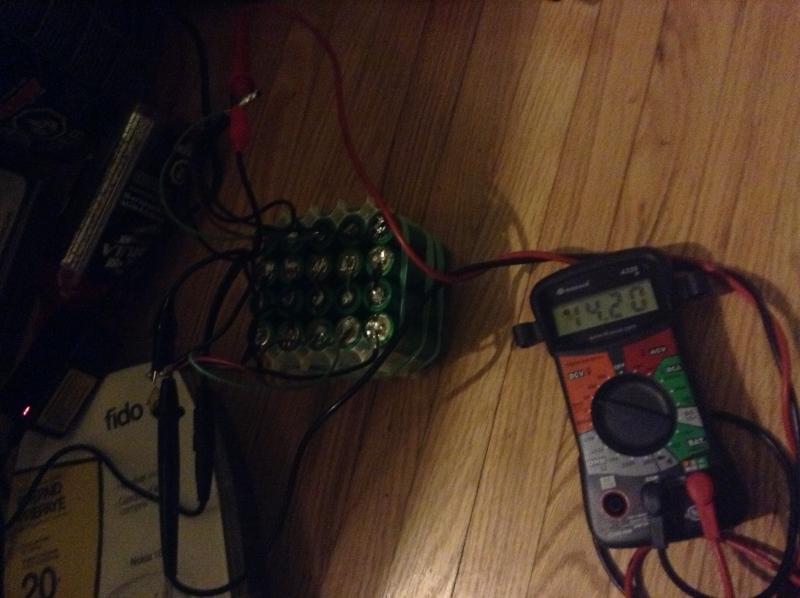Quote:
Originally Posted by echo-francis


and here are the results
normal h4 4.71A 13.13V 61,8423W
h4 sylvania eco bright 4.18A 13.3V 55,594W
h4 leds 1.76A 13.64V 24,0064W
that may not be a good test for everyone because my voltage fluctuate
but that is good for me because i dont use my alt 
the installation is really easy: took me 7 min per side at -10c temp 
I plan to power them with resurrected labtop batteries like I do with my ewp to not drain my main battery

this is my new battery pack in construction. all those cell have a energy density of 160wh/kg  not bad for old 18650 battery.
new good 18650 li ion battery have about 220wh/kg
lifep04 have about 85-125 wh/kg
nimh have 50-80 wh/kg
nicd 40-60 wh/kg
lead acid 30-35 wh/kg 
supercapacitor 4-6 wh/kg |
Ok, wait,
stop!
Lithium ion batteries are VERY DANGEROUS.
Mixing battery brands is
BAD.
Wiring in series willy nilly is
BAD. It requires special consideration to each cell's voltage, each cell must be charged equally or else
BOOM.
Usually Laptop batteries don't have protection circuits built into each cell, so wiring these batteries up willy nilly is a
disaster waiting to happen.
Quote:
|
it's not possible to charge li-ion in series and stay balanced without individual leads going to each cell. This requires charger with multiple channels or balancer module. safest way to charge li-ion cells is in singles! multiple li-ion cells can be charged in parallel. make sure cells are within .5v of each other to prevent excessive currents as cells start to balance each other. charge rate should be set to 1c of lowest rated cell in stack. http://candlepowerforums.com/vb/showthread.php?t=161299
|
I have been a member of candlepowerforums for many years and it has taught me a very wise lesson, don't mess with lithium ion batteries, old and used recycled laptop batteries are an OK source for them but they still aren't safe! The worst source you can get are cells made cheaply in China.
I personally would never use /anything/ but brand new Sanyo 18650's with a protection circuit built into the base of the battery. To prevent overcharge and undercharge.
I'm 30 years old in 2 months and I intend upon keeping the clock ticking, as a result I no longer use any Lithium Ion batteries larger than 14500, 18650 is no longer allowed in my house.
And here I see you are wiring tons of them in parallel/series without a care in the world! WHOA!, it is a disaster waiting to happen!
I will post some examples of what can happen when you aren't 100% careful with charging and discharging them.
A Guide to Lithium Ion Cells in Flashlights | RigCast
greatest danger using li-ion cells occurs during re-charging
Quote:
It is obvious that there are still an unknown number of people who have not yet heard about the dangers with Li-Ion charging. Once you hear about it and understand, then you can take the proper steps to ensure safety.
There are some that believe any of these threads talking about the explosions and fires that can happen relatively easily with Li-Ion charger is like Big Brother trying to shove something down everyone's throat. In reality, it is a thoughtful campaign to simply make people realize that charging Li-Ion cells is not like charging NiCad or NiMH.
Thanks for all the information in this thread.
|
Ultrafire 18650 3000mA exploded
http://www.youtube.com/results?searc...explosion&sm=3
Don't build that battery pack unless you get /someone experienced/ to do it!
Or better yet, get a pre-made battery pack from a Remote control car or an electric scooter!
Quote:
|
it's extremely hard to cause a NMH battery to explode. VS it's relatively easy to cause a li-ion cell to explode by overcharging.
|
NiCD or NiMH isn't without its dangers, don't short circuit ANY battery... for example, but they are a significant measure safer than Lithium Ion technology!!
If you want to make a battery pack for the LED headlights, use a NiMH battery pack and get a proper charge controller!
Failure to do so could result in your car having this kind of thing go off: